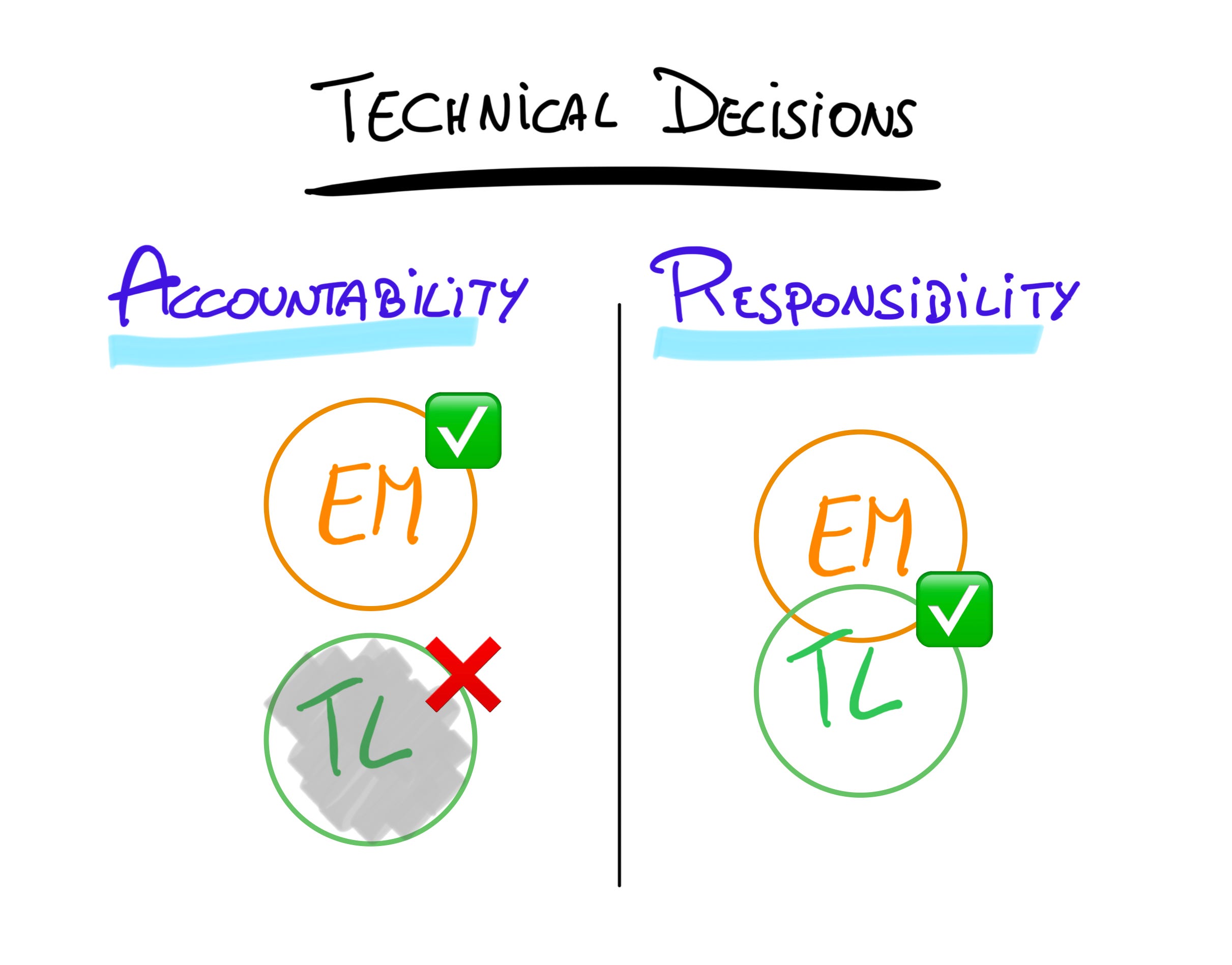Exploring the relationship between Tech Lead and Engineering Manager
- Sergio Visinoni from Sudo Make Me a CTO <makemeacto@substack.com>
- Hidden Recipient <hidden@emailshot.io>
Hi, 👋 Sergio here! Welcome to another free post from the Sudo Make Me a CTO newsletter. If you prefer to read this post online, just click the article title. As this is a free newsletter, I do immensely appreciate likes, shares and comments. That's what helps other readers discover it! Exploring the relationship between Tech Lead and Engineering ManagerA book I recentlu red left me thinking that we could do a better job at helping teams clarifying the relationship between these two roles. Discover my mental model and practical tips.I've recently (re)read The Manager's Path by Camille Fournier. As I wrote in my notes¹, this otherwise great book missed a few opportunities to be excellent. One is that, in my opinion, it didn't explore nearly enough the often confusing relationship between a Tech Lead and an Engineering Manager within a team. In today's article, I want to focus on exploring the blurry boundaries of responsibilities between these two roles. But before we get into the core topic, let's look at another relationship whose boundaries often cause confusion and see if we can draw some parallels. The Relationship between an Engineering Manager and a Product ManagerLots of (digital) ink has been spent exploring the ideal relationship between an Engineering Manager (EM) and its Product Manager (PM) counterpart. In practice, I have seen many interpretations of splitting work and collaborating between these two peers. On one end of the spectrum, you have the setup where PMs are very hands-on and are almost entirely in charge of the entire roadmap for the team, while EMs are little more than glorified executors. In such a setup, it's common for the EM to bring up any arbitrage question with the PM, refraining from making any decision that could require changing plans. I attribute this extreme case to a too-literal interpretation of the PO role from the agile literature. In there, it's often referred to as the person who “owns the team's time,” as such, it's the only one in charge of deciding how to spend it. As the PM is somewhat confusedly considered an evolution of the PO role, it naturally follows that they are responsible for all decisions relating to prioritization. On the opposite end of the spectrum, you find entirely hands-off PMs. They focus on the strategy, designing experiments, processing data, and leaving it entirely to the EM to break things down into deliverables, prioritize work, and ensure it aligns with the directions set by the PM. If we keep stretching the Agile analogy, in such a scenario, the EM is de facto the PO for the team, and the PM is the main stakeholder to serve and support. As is often the case, most teams fall somewhere between these two extremes, where the boundaries between EM and PM are blurred and not wholly clear-cut. I believe that is perfectly fine: the specifics of the relationship will depend on a multitude of factors, including the company culture, team size, and skills and competencies of the two persons covering the roles. What I found helpful, though, is to always stick to the following mental model:
I find this model powerful and effective for a few reasons:
This model is more articulated — and more accurate — than the overly simplistic one that splits the roles between What to do — the PM — and How to do it — the EM. That's because what and how are not entirely orthogonal when building and shipping software. I could devote the entire article to exploring this relationship further, but I'll leave that for another time. Please let me know in the comment section if you'd like a more thorough analysis and evaluation of the PM/EM relationship, and I'll gladly work on it. With this mental model clarified, let's look back at what we came here for: the relationship between the Engineering Manager and the Tech Lead within a team. The Relationship between the Engineering Manager and the Tech Lead.One might be tempted to apply the mental model of “Shared accountability, Split Responsibility” to the EM-TL duo, and some teams do. There is just a problem with it: it's broken. Why can't EM and TL share accountability and split responsibilities?I think this approach is broken based on three fundamental premises. #1 Reporting lines imply accountability In the most common case, and the one we're looking at here, the Tech Lead is part of the team, often a Senior Engineer, and as such, they report to the Engineering Manager who is in charge of the entire team. There are scenarios where there is no TL in the team, and the role is covered by Staff Engineers operating across multiple teams. Alex Ewerlöf has written an excellent article² covering — among other things — why such an approach in that scenario would not make sense. I am not going to repeat what he's written so well already. Simply put, EMs should take full accountability for technical decisions within the team, and as we've seen, they share accountability for the team's outcome with their product peer. Having a Tech Lead is not a hard requirement. Not all teams have Tech Leads. As such, the EM should be able to be in charge of the team's decisions without sharing that responsibility with any other leadership figure. Most teams start off this way, and they only add a Tech Lead later when either the EM workload or the complexity of the scope reaches a point where some extra help becomes highly beneficial. An engineering manager must be capable of leading the technical direction and agenda of the team when no one is covering the tech lead role. These are both technical roles. Unlike the relationship between PM and EM, EM and TL are among equals. They both share a very similar set of competencies in the technical field. Even though a Tech Lead does not manage people, a good one will have a broad portfolio of people and leadership skills that allow them to effectively influence and guide the team through difficult decisions or projects. In many companies, covering the Tech Lead role is considered a requirement for later promotion to Engineering Manager. Given that the skills of an EM and a TL should overlap by 80% or more, there is no natural line for splitting their responsibilities. Despite these considerations, more often than not, we can observe suboptimal configurations where the relationship between the two roles will be oversimplified down to the following:
In such a scenario, the Tech Lead often assumes the traits of the “more equal among peers” to other engineers in the team. At the same time, the Engineering Manager becomes little more than a glorified team secretary. The Tech Lead will often cause frustration and resentment with their peers; the Engineering Manager will progressively lose relevance and career capital, which they'll usually only realize the next time they interview for a role. Why do many teams follow this path if this approach is so detrimental in the long run? In my opinion, it has to do with two main factors at play:
While optimizing for convenience tends to be driven by the individual's need to preserve energy and avoid headaches, the push toward efficiency often emanates from organizational guidelines. Too frequently, companies are eager to sacrifice effectiveness on the altar of efficiency, especially when the side effects materialize on relatively long time horizons. Aiming for a more effective setupMy current thinking is that a more appropriate mental model for the EM/TL relationship is almost the exact inverse of the one that rules the relationship between an Engineering Manager and a Product Manager.
Wait, what do you mean by saying that they share the responsibility? The simplest way to put it is to consider the Tech Lead an extension of the Engineering Manager's bandwidth rather than as a profile that has complementary skills and responsibilities. As such, the responsibilities that the Engineering Manager will share — or delegate — with the Tech Lead will vary depending on the team context: its composition, challenges, priorities, gaps, etc. In turn, the Tech Lead will extend the capacity of the Engineering Manager by taking on some of the following duties:
These are just a few examples that cover the most common cases. They all have in common that they don't identify the responsibility of a Tech Lead in absolute terms, attributing them full decision powers on a team's dimension (Technology, Processes, Staffing, etc). Instead, they'll often assume responsibilities transversally on a slice of the team's scope while consulting and aligning with the EM on the general direction to follow, tradeoffs, and prioritization. Though less efficient on the surface — as it requires more coordination and discussions between the two figures — I consider this approach more effective as it substitutes the efficiency goal with achieving more effective results, including the following:
Considering the broad definition of technical, the Tech Lead role will still have a technical focus. Not one limited to code and architecture but one that encompasses tradeoffs, communication, prioritization, and processes. That is also true for the Engineering Manager, who needs to be both a robust technology leader and a great people leader. I am convinced that a lot of the disfunctional relationship between Tech Leads and Engineering Managers is a consequence of overindexing the differences between the two roles rather than their similarities. I'm curious to hear about other views, as this is one of those topics with as many opinions as individuals, and I'm always trying to come up with a more nuanced perspective. If you found this valuableIf you found this valuable, here are other ways I can help you and your company:
1 Here you can find the article with my full review: 2 See Alex's Article here Sudo Make Me a CTO is a free newsletter edited by Sergio Visinoni. If you found this post insightful, please share it with your network using the link below. If you or your company need help with one of the topics I talk about in my newsletter, feel free to visit my website where you can schedule a free 30 minutes discovery call. I'd be delighted to investigate opportunities for collaboration! |
Similar newsletters
There are other similar shared emails that you might be interested in:

